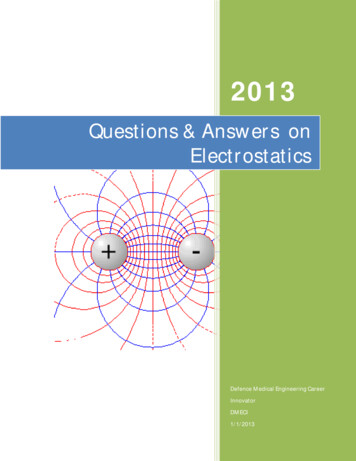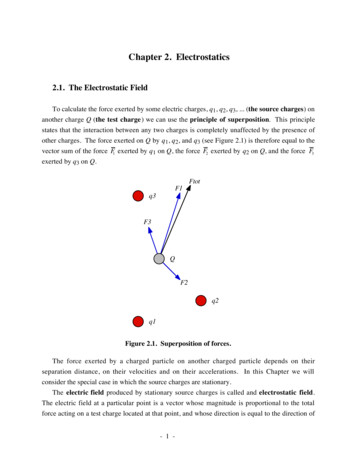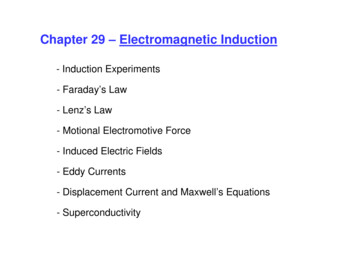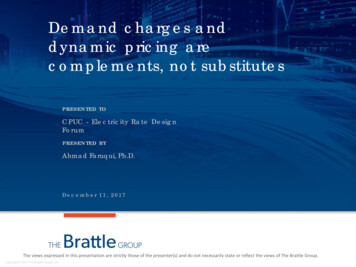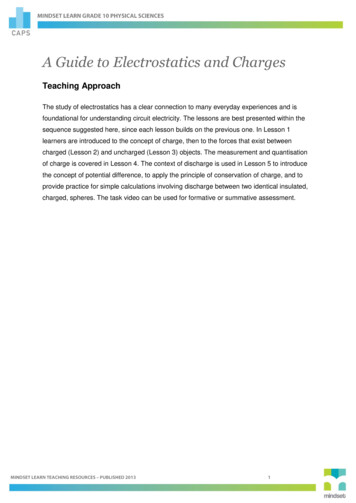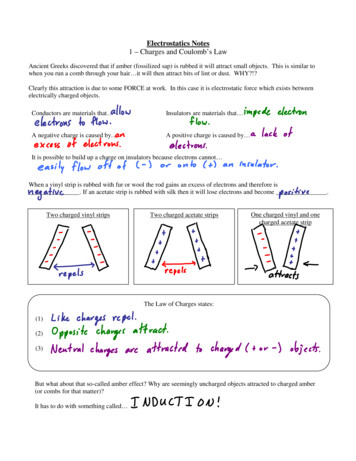
Transcription
Electrostatics Notes1 – Charges and Coulomb’s LawAncient Greeks discovered that if amber (fossilized sap) is rubbed it will attract small objects. This is similar towhen you run a comb through your hair it will then attract bits of lint or dust. WHY?!?Clearly this attraction is due to some FORCE at work. In this case it is electrostatic force which exists betweenelectrically charged objects.Conductors are materials that Insulators are materials that A negative charge is caused by A positive charge is caused by It is possible to build up a charge on insulators because electrons cannot When a vinyl strip is rubbed with fur or wool the rod gains an excess of electrons and therefore is. If an acetate strip is rubbed with silk then it will lose electrons and become .Two charged vinyl stripsTwo charged acetate stripsOne charged vinyl and onecharged acetate stripThe Law of Charges states:(1)(2)(3)But what about that so-called amber effect? Why are seemingly uncharged objects attracted to charged amber(or combs for that matter)?It has to do with something called
Consider a rubber balloon that has been rubbed on someone’s hair and a tin can.Note that the electrons on the can Other examples of electrostatic charges in everyday life include:(1)(2)(3)Ok enough playing around, where’s the formulas?!?Coulomb determined that the force between two charged objects is proportional to their charges and inverselyproportional to the square of their distances or:Where:q1 q2 r k There are two important things to notice from this equation.First, this equation is quite similar to Second, electrostatic forces are much stronger than gravitational forces.There is a very important difference between gravitational and electrostatic forces:Gravity ALWAYS Electrostatic force can When solving for electrostatic forces we will NOT Instead we will determine the direction of the force based on
Example:Two point charges of 1.8x10-6 C and 2.4x10-6 Cproduce a force of 2.2x10-3 N on each other. Howfar apart are these two charges?Example:Two 85 kg students are 1.0 m apart. What is thegravitational force between them?If these two students each have a charge of 2.0x10-3 C,what is the electrostatic force between them?Example:A charge of 1.7x10-6 C is placed 2.0x10-2 m from a charge of 2.5x10-6 C and 3.5x10-2 m from a charge of -2.0x10-6as shown.1.7x10-6 C2.5x10-6 CWhat is the net electric force on the 1.7x10-6 charge?-2.0x10-6 C
Electrostatics Notes2 – Electric Field on a Single ChargeThere are many similarities between gravitational and electrostatic forces. One such similarity is that bothforces can be exerted on objects that are not in contact.In the same way that any mass is surrounded by a gravitational field, we will imagine that any charge object issurrounded by an electric field.Similar to gravitational fields, an electric field will depend on:and the charge.In fact we define an electric field as the force per unit charge:Where:E FE q We can substitute in Coloumb’s Law to get:In the case of electric fields we are dealing with another example of a .Therefore the field is a .In order to show this we always draw the field lines as .Again there is an important difference between gravitational fields and electric fields due to the fact that We therefore define the direction of an electric field as
You will remember that the strength of a vector field is indicated by the density of the arrows, therefore thefield is always strongest Example:What is the electric field strength at a point where a 2.00 uC charge experiences an electric force of5.30x10-4 N?Example:At a distance of 7.50x10-1 m from a small chargedobject the electric field strength is 2.10x104 N/C. Atwhat distance from this same object would the electricfield strength be 4.20x104 N/C?
Electrostatics Notes3 – Electric Field from Multiple ChargesWe have already seen how charged particles emit electric fields, but how do these fields interact when two ormore charges act on each other?Consider two positively charged particles:Note that the electric lines of force work Because this electric field is a force field, it is a vector. So when multiple fields overlap we simply OK, now try two opposite charges:Again the two fields interact, only this time they Example:What is the strength of an electric field midwaybetween a 2.00 uC charge and a -4.00 uC that are 0.60m apart?Example:Two 5.25 uC charges are 0.40 m apart. What is thestrength of the electric field between them at a point0.10 m away from the first charge and 0.30 m awayfrom the second?
Example:Find the magnitude and direction of thet electric fieldat the point P due to the charges as shhown.
Electrostatics Notes4 – Electric Potential, Electric Potential Difference andElectric Potential EnergyFirst let’s examine electric potential energy. If a charged object is in an electric field it has electric potentialenergy - that is it has the potential to move in that field. Note that the potential energy it has could be usedto A non-uniform field, such as that provided by a point, is one which has a different In this case we can derive a formula for the electric potential energy in a NON-UNIFORM FIELD:Again note the similarities between Example:How much work must be done to bring a 4.0 uC charged object towithin 1.0 m of a 6.0 uC charged object from a long way away?NOTE:1. Potential energy is a 2. We WILL In this case, bringing a positive charge near another positive charge requires therefore the workis .Example:How much work must be done to bring a -7.0 uC charged object to within 0.5 m of a 5.0 uC charged object froma long way away?In this case, bringing a negative charge near a positive charge energy therefore workis .
Electric PotentialNow we need to consider a new quantity, electric potential (V). Electric potential is defined as the electricpotential energy per unit charge.Which becomes,NOTE:(1) The electric potential is defined in terms of the moving of a positive charge. Therefore charges - charges.(2) The unit for potential is Example:Calculate the potential at point P as shown in the diagram.3.0 uC5.0 cm140Po50o5.0 cm7.0 cm24.0 uCNOTE:(1)(2)Potentials are We WILL use 3-2.0 uC
Potential DifferenceWe sometimes want to determine the electric potential between two points. This is known as the potentialdifference.For example, given two points A and B, the potential difference between A and B is:NOTE: When we talk about potential at a point we are talking about the potential difference between that pointand infinity, where the potential at infinity is ZERO.Example: What is the potential difference between points A and B due to the charge shown?AB0.50 m1.00 m8.00 uC
Electrostatics Notes5 – Equipotential Lines and Changes in EnergyPotential DifferenceWe sometimes want to determine the electric potential between two points. This is known as the potentialdifference.For example, given two points A and B, the potential difference between A and B is:NOTE: When we talk about potential at a point we are talking about the potential difference between that point andinfinity, where the potential at infinity is ZERO.Example: What is the potential difference between points A and B due to the charge shown?AB0.50 m1.00 m8.00 uCEquipotential LinesTheory: As a charge moves along an electric field line, work is done by the electrical force. The energy gained or lostby this charge moving in the field is a form of potential energy, and so associated with the electric field is anelectric potential, V, which has units of Energy per charge or Joules per Coulomb (also call Volts). Since voltage is potential energy per unit charge, voltage increases when going from a negative chargetowards a positive charge. (The kinetic energy of a positive charge would increase when going from a higherpotential to a lower potential.) A surface along which the potential is constant is called an Equipotential. On a piece of paper, theequipotential is represented by a line on which the voltage is constant.
Topographical Maps: Since gravitational potential energy dependson height, lines of constant height would begravitational equipotentials. A map of suchlines is called a topographical map. Typically,a topographical map shows equally spacedlines of constant elevation. Where the lines are most closely spaced theelevation is changing most sharply, in otherwords the terrain is steep.
Changes in EnergyA 4.0 x10-9 C charge of mass 2.4 x10-21 kg, is initially located at point A, 3.0 m from a stationary 6.0x10-8 Ccharge.a) How much work is required, by an external agent, to move the 4.0x10-9 C charge to a point B, 0.50 mfrom the stationary charge?b) If the 4.0x10-9 C charge is now released from point B, what will be its velocity when it passes backthrough point A?
Electrostatics Notes6 – Electric Potential in Uniform Electric FieldsWe have seen that the electricfield surrounding a pointcharge is not uniform –that it If we examine the electric fieldbetween charged plates we willfind that it is Notice that the density of the lines is also In a uniform electric field we cannot use our previous formula:This formula is only valid for describing the strength of non-uniform fields (point charges only!!!)To find an equation for uniform fields, we will once again draw a parallel withgravitational potential energy.Consider a mass sitting in a uniform gravitational field at some height.The mass will tend to move from As it does it If we allow the mass to fall the work done on it (W ) is negative. If we wantto lift the mass to a certain height we need to do positive work on it.A charged object in an electric field will behave in the same way, accelerating froman area of As it does it In the same way that we would do positive work on an object to lift it againstgravity, we need to do work to bring a positive charge near a plate with positivepotential.To calculate the work done in this case we can use the formula:W Δ Ep FdIt is often easier, however, to describe the work done in a uniform field using thepotential difference between the two plates.Recall that potential difference: V A potential difference is generated any time we have areas of high and low potentialenergy, just like those generated by gravitational fields.
In order to determine the electric field between two charged plates we must use the formula:Where:Example:Calculate the electric field strength between twoparallel plates that are 6.00x10-2 m apart. Thepotential of the top plate is 6.0 V and the bottomplate is -6.0 V.E V d Example:An electron is accelerated from rest through apotential difference of 3.00x104 V. What is the kineticenergy gained by the electron?Example:A proton, initially at rest, is released between two parallel plates as shown.a) What is the magnitude and direction of the electric field?b) What is the magnitude of the electrostatic force acting on the proton?c) What is the velocity of the proton when it exits the - 400 V plate?
Electrostatics Notes8 – Cathode Ray TubesNon-flat screen TVs and monitors work by directing a beam of high speed particles at a film of fluorescingchemicals. These charged particles are accelerated by electrically charged plates. After they are sped up, thebeam can be directed by very precise control of another set of charged plates. Consider the following problem:Example:A beam of electrons is directed to a region between oppositely charged parallel plates as shown in the diagrambelow.1) The electron beam is produced by accelerating electrons through an electric potential difference of 380 V.What is the speed of the electrons as they leave the 380 V plate?2) What is the electrostatic force on electrons in the region between the horizontal plates when they areconnected to a 9.0 V potential difference?3) What is the acceleration of the electrons between the deflecting plates?4) What is the final magnitude and direction of the velocity of the electrons as it leaves the second set of plates?5) How could you cause the beam to benda. more?i)ii)b. less?i)ii)
1 - Charges and Coulomb's Law Ancient Greeks discovered that if amber (fossilized sap) is rubbed it will attract small objects. This is similar to when you run a comb through your hair it will then attract bits of lint or dust. WHY?!? Clearly this attraction is due to some FORCE at work.
